Understanding the Best Suet Bird Feeders for All Birds
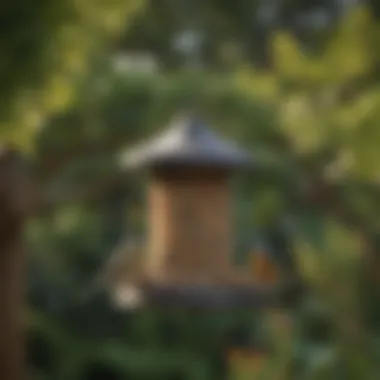
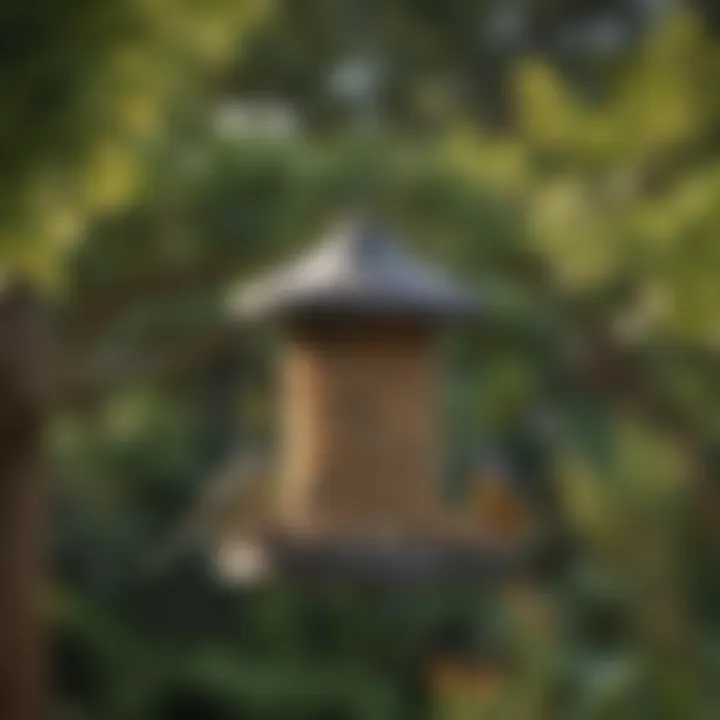
Intro
Suet bird feeders play a crucial role in attracting a variety of bird species to your garden or yard. These feeders are designed specifically to hold suet, which is a high-energy food often favored by many birds, especially in colder seasons. Understanding the significance of suet bird feeders can enhance your birdwatching experience, providing you with opportunities to observe these creatures up close. This article will cover the different types of suet bird feeders available, essential features to consider when selecting one, and a review of some of the top products on the market. Moreover, insights into maintenance and placement strategies will be provided to ensure optimal bird feeding experiences. By offering detailed guidance, this piece aims to elevate the understanding of these vital bird feeding tools for both new and experienced bird enthusiasts.
Care Tips
Caring for suet bird feeders is essential to ensure they remain effective and attract birds consistently. Here are some detailed tips categorized into key areas:
Daily Care Routines
Every day, check the suet feeder to see if it is empty or has debris. Clean any leftover food particles that could attract pests or foster mold growth.
Cage Setup and Maintenance
When installing your suet feeder, choose a location that is sheltered but visible. This attracts birds while allowing them to feel safe. Make sure the feeder is secure and cannot sway in the wind.
Hygiene and Cleaning Practices
Regularly clean your suet feeders. Use warm, soapy water to wash it, ensuring to rinse thoroughly afterward to remove any soap residue. This is important to prevent the spread of diseases among birds.
Seasonal Care Adjustments
Adjust the type of suet offered based on the seasons. During colder months, energy-rich suets made with beef fat or peanut butter are optimal. In warmer weather, consider using less fatty options to prevent spoilage.
"Proper care of suet feeders not only supports bird health but also enhances your birdwatching experience by attracting a larger variety of species."
Behavioral Insights
Understanding bird behavior at suet feeders can provide deeper insights into attracting diverse species. Here are some aspects to consider:
Understanding Bird Body Language
Birds exhibit different body languages, such as wing flapping or calls, which can indicate their comfort level. Observing these signs can help you gauge how well your feeder is performing.
Common Behavioral Issues and Solutions
Aggressive behaviors among competing birds are common at feeders. To alleviate this, consider adding multiple feeding stations in different locations.
Positive Reinforcement Techniques
Using different types of suet can encourage more birds to visit. Birds learn quickly, and varied offerings can promote repeated visits.
Social Interaction Needs
Many bird species are social. Using multi-bird feeders can accommodate groups, encouraging more regular feeding and interaction.
Nutrition Guides
Providing the right nutrition is crucial for the birds. Key components to consider include:
Essential Diet Components
High-fat content is essential during winter. Suet made with seeds and nuts can provide balanced nutrition for different bird species.
Safe and Toxic Foods
While suet is typically safe, avoid using ingredients like chocolate or avocado, which are toxic to birds. Research safe options for your suet recipes.
Supplements and Treats
Incorporating fruits or seeds can enhance the nutritional value of the suet provided. Consider adding mealworms as a treat for insect-eating birds.
Feeding Strategies for Different Species
Some species prefer hanging feeders, while others may prefer ground feeding. Tailor your setup based on the types of birds in your area.
Wellness and Health
A healthy population of birds is vital for the ecosystem. Here are practices for ensuring their well-being:
Routine Health Checkups
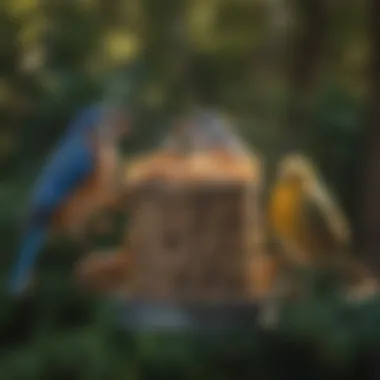
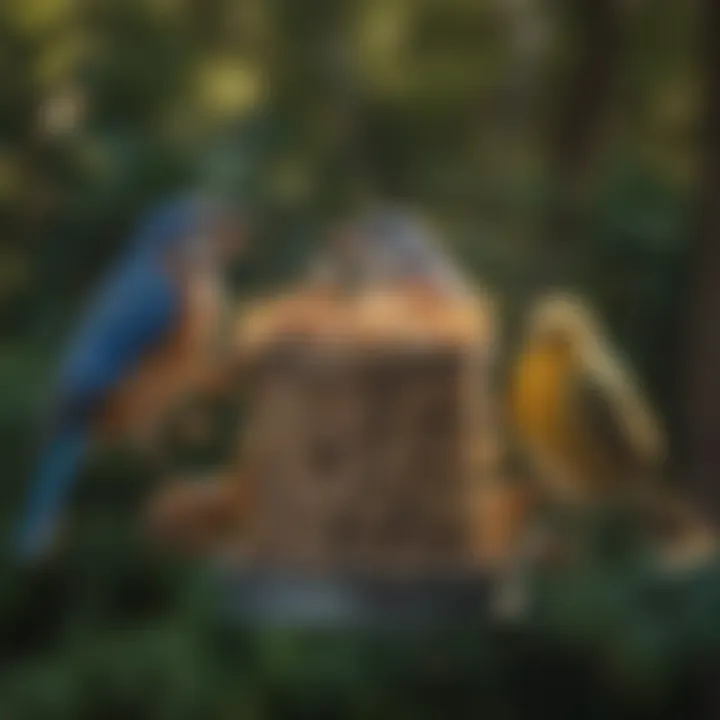
Observe your feeding area for signs of sick birds. Regular visits and observation can help identify potential issues early.
Identifying Symptoms of Illness
Look for changes in behavior, such as lethargy or disinterest in food. This may indicate health problems that need addressing.
Preventative Care and Vaccinations
While specific vaccinations for wild birds are limited, providing clean feeders and fresh food can greatly lessen potential health risks.
Mental and Emotional Well-being
Ensuring an enriching feeding environment with varied food types can improve the overall well-being of visiting birds.
Enriching Activities
Ensuring that feeding stations are engaging can lead to more frequent visits. Consider the following:
Toys and Playtime Ideas
Set up birdbaths nearby for added engagement. Birds enjoy splashing around and fresh water encourages them to stay longer.
Training and Tricks
Birds can be conditioned to come to specific feeders. Gradually adapting feeding times can help establish reliable feeding routines.
Outdoor Activities and Interaction
Encourage birdwatching as a family activity, making it a shared experience that promotes learning about nature.
DIY Projects for Mental Stimulation
Create homemade bird feeders or suet cakes as projects to boost mental stimulation for both birds and birdwatchers.
Each of these sections has significant implications for birdfeeding experiences. Understanding the components of suet feeders and their role in bird nutrition enhances engagement with wildlife.
Prologue to Suet Bird Feeders
Suet bird feeders play a significant role in the lives of both birds and bird enthusiasts. They provide an essential food source that attracts a variety of species, especially during colder months when natural food becomes scarce. The right suet bird feeder can make a substantial difference in enriching one's backyard environment and supporting local wildlife. Understanding the different types and features of these feeders is crucial for anyone looking to optimize their birdwatching experience.
Definition and Purpose
Suet bird feeders are specialized feeding devices designed to hold suet, a high-energy food made from animal fat. These feeders typically come in several forms, each catering to specific bird species. The primary purpose of these feeders is to provide a nutritious food source that is particularly attractive to woodpeckers, nuthatches, and various other birds. The ease of installation and lightweight construction appeal to many bird lovers, as it allows for flexible placement throughout the yard.
In addition to their primary function of feeding birds, suet feeders also play a role in educating the public about avian species. They can serve as a focal point for observing different birds, encouraging interest in nature and conservation. By using suet feeders, enthusiasts can actively engage in the stewardship of wildlife, fostering an environment that is rich in biodiversity.
The Role of Suet in Avian Nutrition
Suet is packed with essential fats and proteins that are vital for birds, providing them with the energy needed for daily activities such as foraging and nesting. During winter months or other times of food scarcity, birds rely heavily on suet for sustenance. The fat content helps keep their energy levels high, making it easier to survive harsh conditions.
Suet helps support various essential functions in birds. For instance, it aids in feather maintenance, fostering healthy plumage essential for insulation and flight. Moreover, it contributes to reproductive success by providing the necessary nutrients for the development of healthy embryos. Whether it is during migrations or breeding seasons, suet is a crucial dietary component.
In summary, suet bird feeders are more than just simple devices for feeding birds; they form an integral part of wildlife habitats, helping to connect people with nature while promoting avian health and growth.
Types of Suet Bird Feeders
Suet bird feeders play a crucial role in attracting a variety of birds. Understanding the different types of suet feeders can help bird enthusiasts select the right one for their needs. Each type comes with unique features, benefits, and considerations. Knowing these factors can optimize the bird-feeding experience and enhance the beauty of your yard.
Hanging Feeders
Hanging feeders are perhaps the most common type found in many backyards. These feeders are typically suspended from trees or hooks. They often come with a compartment to hold suet cakes. The major advantage of hanging feeders is their versatility; they can be placed at varying heights to attract different bird species. Additionally, they can be easily moved if required.
When using hanging feeders, it is essential to select a location that is sheltered from strong winds and rain. This influences how frequently birds visit. A well-placed hanging feeder will provide birds a safe environment and encourage their return. Keep in mind that some birds may feel vulnerable. Thus, consultation with local birding guides can add important insights about suitable locations.
Platform Feeders
Platform feeders are another option, offering a broad surface for feeding. They provide an excellent space for multiple birds to eat simultaneously. Their design allows for various types of feeds, making them flexible. Suet cakes can be placed directly on the platform, and other food options can be added to attract an even broader range of species.
The open design of platform feeders does require vigilance regarding potential predators, such as cats or hawks. Additionally, if you live in an area with squirrels, a platform feeder might encounter some challenges. Using a baffle can help reduce this risk. Platform feeders often require more maintenance, as they are exposed to elements that can lead to feed spoilage. Periodic cleaning of the surface ensures that birds remain healthy.
Caged Feeders
Caged feeders provide a different approach. These feeders usually have protective cages around them, allowing smaller birds to access the feed while keeping larger birds and animals away. The cage design protects suet from being devoured by unwanted visitors, ensuring that smaller birds can feed comfortably.
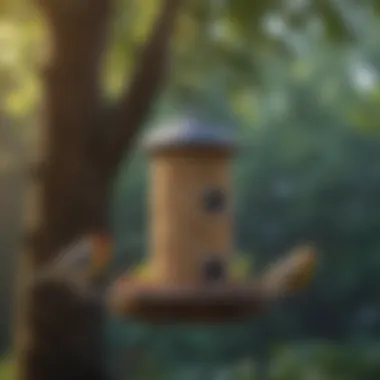
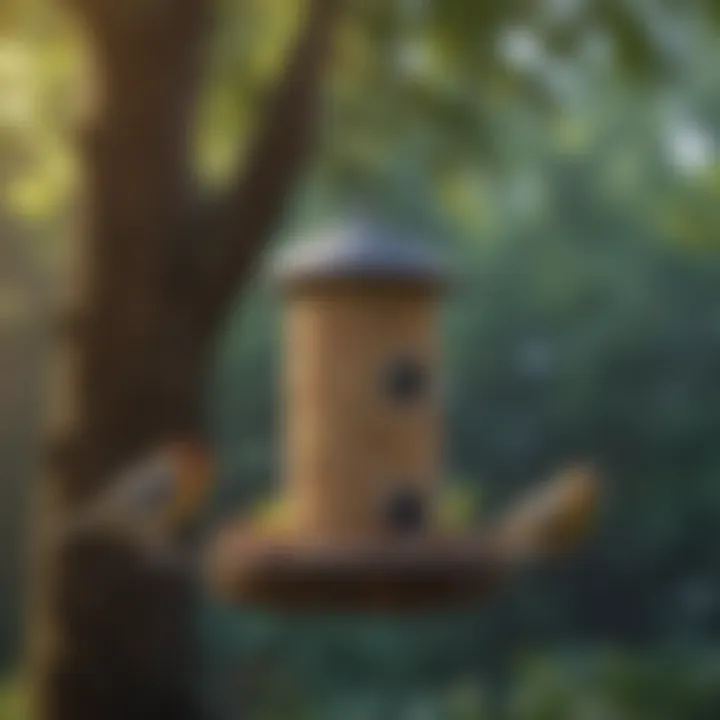
Caged feeders can be especially beneficial in mixed bird environments. They encourage the presence of desirable species, as larger birds are often deterred. However, placement is key; a caged feeder should be positioned where birds feel secure yet safe from predators. Familiarizing oneself with local bird species can help select appropriate caged feeders.
Suet Blocks vs. Cakes
When it comes to suet options, the choice between suet blocks and suet cakes can seem trivial but holds importance. Suet blocks are usually denser compared to cakes. They are often a good choice for caged feeders as their solid form is less likely to crumble.
On the other side, suet cakes tend to have more variety in mixtures. They may include seeds, fruits, or insects, attracting various birds. Examining both options can assist in determining what works best in their specific situation, as well as what songbirds frequent their area. Experimentation often leads to finding the ideal choice for specific feeding stations.
Ultimately, selecting the right type of suet feeder contributes to a rewarding bird-watching experience. Whether you choose hanging, platform, or caged feeders, understanding the unique qualities can greatly enhance bird attraction and visitation.
Key Features to Consider
When selecting a suet bird feeder, understanding key features is crucial. The right design can significantly affect the feeder's functionality, durability, and the bird species attracted. Assessing these features will help you choose the best suet feeder tailored to your avian interests.
Material Durability
Durability is a critical aspect of any suet bird feeder. Feeders made of sturdy materials like metal or high-quality plastic tend to last longer compared to those made from inferior materials. Metal feeders can resist chewing from squirrels or other animals. Plastic options should be UV-resistant to prevent fading or cracking from sun exposure. Ultimately, choosing feeders constructed from durable materials not only serves to protect your investment but also ensures consistent availability of food for birds, even in harsh conditions.
Ease of Cleaning
Cleanliness is vital for keeping your feathered friends healthy. Suet feeders can accumulate debris, old food, or mold if not cleaned regularly. Select a feeder that allows for easy disassembly or has a design that simplifies the cleaning process. Look for models featuring removable trays or those that can be wiped down quickly. The easier it is to clean, the more likely you will maintain a regular cleaning routine. This practice helps ensure that feeder hygiene maximizes the nutritional benefits of suet for the birds.
Squirrel-Proof Options
Squirrels can be a nuisance when it comes to bird feeding. They often raid feeders, consuming the food intended for birds. Investing in squirrel-proof feeders can save you from this aggravation. Many manufacturers offer feeders with designs that deter squirrels, such as weight-activated mechanisms or cages. These options allow smaller birds to feed while preventing squirrels from gaining access. Researching and choosing squirrel-proof models can prolong your feeder's effectiveness and make your bird feeding experience more rewarding.
Weather Resistance
Weather resistance is another essential feature to consider. Feeders should withstand different elements, especially if they are placed outdoors. Rain, snow, and extreme temperatures can affect the integrity of the feeder and the suet inside. Select feeders that are designed to resist water and provide shelter to suet from harsh conditions. This feature ensures food remains fresh and available for birds, regardless of the weather.
Review of the Best Suet Bird Feeders
In this section, we will examine the best suet bird feeders available on the market. Choosing the right feeder is crucial for providing birds with a reliable source of energy and nutrition. The different types of feeders cater to diverse bird species, ensuring that your yard attracts various avian visitors. By understanding the core features, readers can make informed decisions based on their specific needs and the characteristics of their local bird populations.
Top-Rated Hanging Feeders
Hanging feeders are popular due to their versatility and ease of use. These feeders can be hung from trees, hooks, or poles, providing an inviting space for birds to feed. Some top-rated hanging feeders include the Droll Yankees Suet Dome, which offers fantastic protection against larger birds. It features a sturdy design, ensuring that it withstands strong winds and rain. Another excellent choice is the Woodlink Absolute II, praised for its squirrel-proof design. This feeder has a protective cage that allows only smaller birds to access the suet, making it ideal for bird watchers who want to discourage unwanted visitors.
Best Platform Feeders
Platform feeders provide a flat surface that allows for multiple birds to feed simultaneously. They are advantageous for attracting various species that prefer feeding on open surfaces. The platform feeder by More Birds is one of the top choices, featuring drainage holes to keep the suet dry. Its solid construction ensures durability, making it suitable for outdoor use year-round. Another commendable product is the Birds Choice Platform Feeder, which combines aesthetics with functionality. Its easy-to-clean feature and unique design make it both practical and beautiful for any yard.
Most Effective Caged Feeders
Caged feeders offer a protective barrier around the suet, allowing only smaller bird species to access the food. This can be beneficial in areas where larger birds or squirrels are overly aggressive at feeding sites. The Brome Squirrel Buster Suet Feeder is particularly effective, designed to prevent both squirrels and larger birds from accessing the suet. Its adjustable weight mechanism provides an excellent method for achieving the right balance. Additionally, the Heath Outdoor Products Caged Suet Feeder is another option known for its high durability and ease of cleaning. Both options enhance the feeding experience while ensuring that smaller birds can enjoy the suet.
Comparative Analysis of Features
When comparing different suet bird feeders, several features come into play.
- Design: A good feeder should accommodate various bird sizes and be easy to maintain.
- Material: Look for items made from weather-resistant materials that can withstand environmental changes.
- Accessibility: Some feeders offer features that allow for easy cleaning and refilling, essential for maintaining a good feeding environment for birds.
In summary, by reviewing the best suet bird feeders, one can recognize the significance of selecting the right feeder based on specific needs. It allows for a rewarding bird-watching experience, where one can observe and enjoy the richness of nature.
Maintenance of Suet Bird Feeders
Maintaining suet bird feeders is crucial for ensuring a healthy feeding environment for birds. Proper maintenance enhances the effectiveness of the feeder, increases the longevity of the product, and fosters better attraction among various bird species. Without routine care, feeders can become less appealing to birds, potentially leading to fewer visits and inadequate nutrition. This section discusses essential maintenance practices such as regular cleaning routines, effective refilling strategies, and inspecting for damage.
Regular Cleaning Routines
Cleaning suet feeders should be a regular routine. Over time, residues and organic materials may build up. Bacteria, mold, and leftover food particles can compromise the feeding experience and potentially harm birds. The primary aim of a cleaning routine is to ensure that the feeder is hygienic and free from harmful contaminants.
- Check feeder at least every two weeks, or more frequently during warm weather.
- Remove old suet and clean with warm water and mild soap. Rinse thoroughly to remove any soap residue.
- For stubborn residues, consider using a soft brush or a sponge.
- Allow feeder to air dry completely before refilling with fresh suet.
Following these steps helps assure that the feeder continues to attract birds while preventing health risks.
Refilling Strategies
Strategically refilling suet feeders is an important part of maintenance as it encourages bird visits. It is vital to refill suet when it is low or empty, but also maintain awareness of other factors such as seasonal changes in bird activity. Here are some strategies you can follow:
- Timing is important: Refilling early in the morning or late afternoon can attract birds at their most active times.
- Monitor consumption rates: Adjust refilling frequency based on how quickly birds consume suet, which may vary seasonally.
- Use high-quality suet: Ensure that the suet you offer is fresh and appealing to maximize bird attraction.
- Consider weather: During extreme weather, birds may need more energy, so refilling may need to happen more often.
By implementing these strategies, you can ensure that birds remain interested in your feeder throughout the year.


Inspecting for Damage
It is equally important to inspect the suet bird feeders for any signs of damage. Wear and tear can occur from various factors, such as weather conditions and animal interactions. Not addressing these issues can reduce the feeder's effectiveness or lead to unsafe feeding conditions. Here are some key aspects to consider when inspecting:
- Check for cracks or breaks: Examine feeder materials regularly to ensure they are intact.
- Locks and openings: Ensure that all feeding areas remain secure and that birds cannot escape.
- Stabilize structure: Make certain that the feeder hangs or sits firmly to prevent falls that may deter birds.
- Rust and corrosion: Metal components may rust, so inspect and replace parts as necessary for longevity.
Regular inspections not only prolong the life of suet feeders but also guarantee that they remain welcoming environments for avian visitors.
Consistent maintenance improves the overall functionality of suet feeders and contributes to a better avian feeding experience.
Optimal Placement of Suet Bird Feeders
An effective placement of suet bird feeders is crucial for attracting a variety of birds to your yard. Placement not only influences which birds visit but also helps minimize unwanted visits from pests such as squirrels and raccoons. Properly positioning your feeder ensures that birds feel safe while feeding, thus promoting a healthy avian ecosystem in your area.
Ideal Locations in Your Yard
Selecting the right location for your suet bird feeder involves several factors. Ideally, place your feeder in a spot that offers some cover, such as near trees or shrubs. This allows birds to hide from predators while feeding. Additionally, proximity to water sources can further enhance attraction, as many birds prefer to mix feeding with drinking.
Consider open spaces that provide birds a clear line of sight, enabling them to spot danger. Placing the feeder at least 10 to 15 feet from structures helps deter squirrels, as they are less keen to risk exposure. Remember to avoid direct sunlight, which can melt the suet and make it less appetizing.
Height Considerations
The height at which you hang your suet feeder plays a significant role in attracting different bird species. Most birds prefer feeders placed at a height between five to six feet. This height is accessible yet high enough to deter many predators.
However, certain species like woodpeckers and nuthatches are comfortable approaching feeders mounted higher on trees. Moreover, adjusting feeder height seasonally can increase efficiency. For example, lowering the feeder when fledglings are around can assist young birds in learning to feed. Be mindful of accessibility; ensure that you can refill or clean the feeder without difficulty.
Environmental Factors to Consider
Environmental elements should not be overlooked when placing your suet bird feeders. Wind and weather can significantly affect feeding behavior. Choosing sheltered locations can protect the feeders from harsh winds. Excessive rain or snow can spoil the suet or make feeding difficult. Therefore, some thoughtful preparation is necessary.
Also, consider the seasonal changes in bird behavior. In colder months, birds may prefer sheltered placements as they seek warmth. In contrast, during spring and summer, they might be more comfortable in open areas where they find abundant natural food.
It's useful to monitor how birds interact with the feeder over time. Adapt your placement based on which species are taking advantage of your suet offerings or if some adjustments improve visitation rates.
Key Takeaway: Proper placement of suet feeders can significantly enhance birdwatching experiences and attract diverse species. Focus on cover, height, and environmental factors for best results.
Bird Species Attracted by Suet Feeders
Suet feeders play a crucial role in attracting a variety of bird species, enriching the backyard ecosystem and providing countless hours of observation. Understanding which birds are likely to visit these feeders can enhance the feeding experience and increase the chances of attracting diverse avian visitors. Suet serves as a highly nutritious food source, particularly during colder months when other food options are scarce. The fat content in suet is essential for birds, offering them the energy needed for survival and breeding.
Common Backyard Birds
Many species commonly found in backyards are particularly attracted to suet feeders. Woodpeckers, such as the Downy Woodpecker and the Red-bellied Woodpecker, are frequent visitors. They enjoy hammering into the suet, extracting the tasty fats inside. Chickadees, with their curious nature, are also quick to explore these feeders, often seen hanging upside down to grab a bite.
Nuthatches, known for their unique climbing abilities, are adept at managing the suet block while blue jays and cardinals can also be frequent guests. These birds rely on suet not only as a food source but also to provide energy for their busy lifestyles. Ensuring a constant supply of suet can lead to consistent visits from these beautiful backyard residents.
Seasonal Bird Variations
Bird watching can be a dynamic activity throughout the year, as different species arrive with changing seasons. During spring and summer, the breeding season brings many new visitors. Birds like the American Goldfinch and house wrens may show increased activity as they search for high-energy food sources to feed their young.
In contrast, winter often sees an influx of various species prioritizing energy intake to withstand the cold. Dark-eyed Juncos, sparrows, and even some frigid-weather residents like the red-breasted nuthatch can become common sights around suet feeders. Observing these seasonal changes brings an additional layer of excitement and engagement for avid bird watchers.
Attracting Rare Birds
For those looking to attract more unusual species, suet feeders can offer a viable solution. Birds like the Yellow-bellied Sapsucker or the occasional Hairy Woodpecker may strike up an unexpected visit. It is essential to create a diverse feeding environment, providing different types of suet blends that cater to various avian diets.
Utilizing specific suet recipes that incorporate seeds, nuts, or dried fruit can pique the interest of rarer birds. Having multiple feeders installed, each designed for different species, can further enhance the likelihood of drawing in unique birds. Regularly monitoring and documenting the visitors can help to identify trends and improve future bird attraction strategies.
End
In this article, we have explored the various aspects of suet bird feeders and why they are essential for attracting a broad range of bird species. Suet feeders are not merely feeding devices; they play a crucial role in avian nutrition and support birdwatchers' enjoyment. Understanding the key features and maintenance requirements is fundamental for both novice and experienced bird enthusiasts who wish to optimize their feeding stations.
The conclusion emphasizes the importance of correctly selecting and maintaining suet feeders to ensure they function effectively. Key elements include the type of feeder, materials used, ease of cleaning, and even placement in your yard. Each consideration directly impacts how many birds visit and how frequently they return. For example, squirrel-proof options may be essential in some yards while, in others, focusing on ease of cleaning can prove beneficial.
"A well-maintained suet feeder can attract more than just common birds; it can invite a diverse range of species you may not expect."
Recognizing the seasonal variations in bird species can also enhance your experience. Adjusting your feeding strategy based on the time of year ensures you cater to the dietary needs of the birds inhabiting your area.
Summary of Key Points
- Understanding Suet's Role: Suet serves as an energy-rich food source beneficial for various bird species.
- Types of Feeders: Different feeders serve distinct purposes, attracting different kinds of birds.
- Key Features: Material durability, cleaning ease, squirrel resistance, and weather resilience are critical features to consider when selecting a feeder.
- Maintenance Practices: Regular cleaning and inspection can prolong the life of your feeder and attract more birds.
- Optimal Placement: Positioning your feeder in suitable locations can significantly influence bird traffic.
- Bird Species: Being aware of common and seasonal birds helps in tailoring your feeding strategy.
Final Recommendations
Lastly, here are a few essential tips to enhance your experience with suet bird feeders:
- Select the Right Feeder: Consider your specific environment and the typical bird species that frequent your area. Choose a type that suits your needs, whether it be hanging or caged.
- Regular Maintenance: Develop a routine for cleaning and refilling your feeder. This will help in keeping it attractive to birds and extending its lifespan.
- Observe Behavior: Spend some time watching the birds that come to your feeder. This observation can provide insight into their preferences and behaviors, helping you adjust your strategies accordingly.
- Be Patient: It may take time for birds to discover new feeders. Consistency is key.
- Share Your Findings: Engage with other bird enthusiasts through platforms such as Reddit or Facebook to share experiences and tips.
By following these recommendations, you can create a welcoming feeding environment that attracts a multitude of birds and enriches your understanding of these fascinating creatures.















